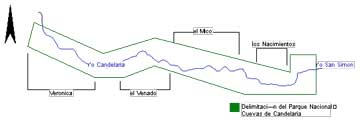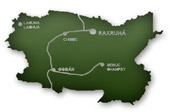ITS HISTORY
LOS NACIMIENTOS forms part of the NATIONAL PARK CAVES OF CANDELARIA. This complex of caves, is considered a place of spiritual convergence for the old pre-Hispanic inhabitants of the area, reason for which, it is considered an archaeological and sacred place for the Mayans.
The Candelaria River upon penetrating under the mountains of San Simón, has formed vast tunnels of enormous proportions, generating a quite peculiar hydro espeleologist system (current of underground water), that possesses a total extension of 12.56 kilometers in length.
These sacred Mayan caves described in the book Popol Vuh (The Genesis of the Mayans) were rediscovered in 1974 through the ¨Mission of Studies and of Espeleolosgist Investigations in Guatemala¨, put forward by the French and Guatemalan governments, and directed by the French Caver Daniel Dreux.
In 1975, a scientific group of cavers carried out a topographical study in which they established that the main gallery is 22 kilometers long. If the water streams, annex galleries and upper systems are considered, then the total development can be reckoned at more than 80 kilometers. This is the longest underground system found in Latin America.
The Caves of Candelaria Complex is divided into four main areas:
- Verónica
- El Venado
- El Mico
- Los Nacimientos
- Brent Woodfill
- Carlos Giron
- Alvaro Ramirez

In 2001, a group of archeologist from Vanderbilt University, led by Dr. Arthur Damerest drew the blueprint of Los Nacimientos Caves and explored the last two kilometers of the underground river system (Candelaria River), which turned out to be the safest area for adventure tourism.
MAYAN OCUPANCY
The caves the Candelaria River were explored in February and March of the year 1975. The studies verified that the caves were utilized like a place of worship. The numerous architectural elements (walls, stairs, platforms, cornices), the petroglifes
(Graphic representations engraved in rocks or stones), the animal pictograms, the sculptures and the burials evoke the sacred entity of these places, rejecting at the same time the domestic or defensive hypothesis of use of the galleries. The ceramics and the appliances found indicate with plenty of certainty an intense occupation of the places during the pre-Hispanic period known as Early Classical (250-600 DC) and Late Classical (750-850 DC) periods. The different types of ceramics reveal a more marked influence of the places of central Petén (Uaxactún particularly) than any of the places located at the lower level of the Passion River.
ARCHEOLOGICAL DATA
Studies carried out by the archaeologist Brenth Woodfill and collaborators in 2004 discovered the occupation of an area close to the entrance of the caverns with traces of a Mayan family as remainders of utensils and a variety of pottery were found.
ACKNOWLEDGMENTS
Dr. Arthur Demarest
Archeologists:
BIBLIOGRAPHY
Thesis: “Design on an Ecotourism Complex at Caves of Candelaria”
Architect Maria Gabriela Lemus, Universidad Rafael Landivar, Guatemala.
June 2005
Caves Thematic Guide. Draft environmental conservation and income-generating component of environmental education.
Lic. Michelle Bonham with the support of Peace Corps, Counterpart International, Aprobasank and the school Board of Candelaria Camposanto.





